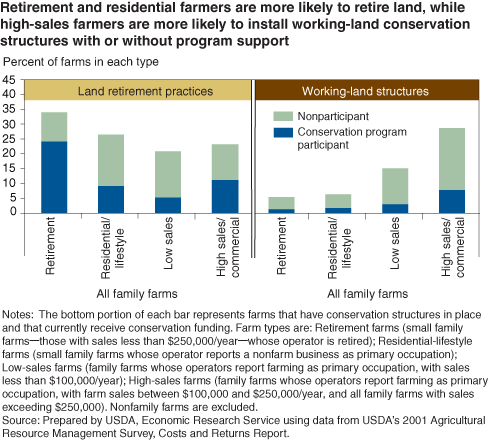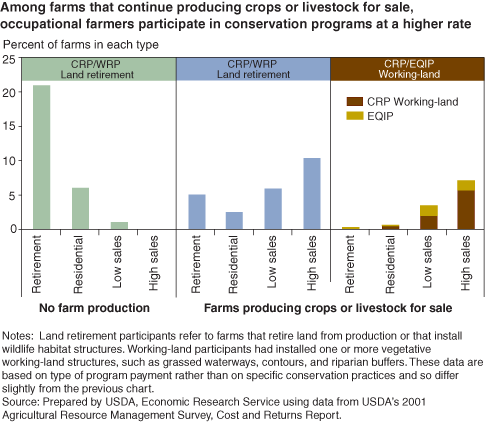Land Retirement and Working-Land Conservation Structures: A Look at Farmers' Choices
- by Dayton Lambert and Patrick Sullivan
- 6/1/2006
Highlights
- Roughly 37 percent of farm operators had retired cropland from production or had working-land conservation structures in place in 2001. Of these, 36 percent received conservation payments.
- Operators of smaller retirement and lifestyle farms are more likely to retire farmland.
- Operators of larger farms are more likely to adopt conservation measures that are compatible with farm production.
Operators of all types and sizes of farms have adopted conservation-compatible farming practices and installed conservation structures. Many farmers do so for sound business reasons—to protect the productive capacity of their farmland, to reduce seed, fertilizer, and other input costs, or to save time and labor. However, the costs of conservation practices that primarily create off-site benefits to society—in the form of cleaner air, improved water quality, and a healthier ecosystem—often pose significant barriers to their adoption by farm operators. To encourage these efforts, USDA provides technical and financial support to farm and ranch operators through a diverse set of conservation programs that either retire environmentally fragile land from production or encourage the adoption of conservation-friendly farming practices. Recent ERS research suggests that farms and farm households that install working-land conservation structures (such as contour strips or grass waterways) often differ from those that retire farmland. Therefore, as working-land program budgets increase, the mix of farms participating in USDA’s conservation programs may change.
The effectiveness of a conservation program depends on the choices farm operators make because adoption of conservation practices is voluntary. But, despite the importance of farmers in determining environmental outcomes, relatively little is known about those who adopt conservation practices and participate in USDA’s conservation programs, and why they do so. A recent study by ERS found that household characteristics and operator attributes such as age, gender, educational attainment, household size, and dependence on off-farm income affect the types of conservation efforts farm operators are likely to engage in, as well as the types of conservation programs they are likely to find appealing (see box, “An Array of Conservation Programs Is Available to Farmers”). For example, older farm operators and those focused on a nonfarm occupation are less likely to install working-land conservation structures than younger farm operators whose primary occupation is farming. As a result, programs supporting a wide array of alternative conservation practices are most likely to match the interests of a wide range of farmers.
Different Conservation Structures Are Used by Different Types of Farms
Farm practices that are potentially compatible with USDA’s conservation goals fall into three broad categories: (1) adopting farm management practices, such as conservation tillage; (2) installing working-land structures, such as grass waterways; and (3) retiring land from agricultural production. While a high percentage of farms have adopted one or more conservation-compatible farm management practices (see the February 2006 issue of Amber Waves), the focus here is on working-land structures and land retirement. These two types of practices account for most of the conservation payments that farmers receive and their adoption is likely to depend more on conservation program subsidies than the adoption of new farm management practices.
USDA’s 2001 Agricultural Resource Management Survey (ARMS) provides data on characteristics of farm businesses and households that have installed a select group of conservation practices, with or without the financial support of conservation programs. About 37 percent of farm operators had retired whole farmland fields from production; dedicated farmland to wildlife habitat; or installed grass waterways, filter strips, and riparian buffers (trees planted along stream banks) as of 2001. Each of these vegetative structures can reduce unwanted environmental impacts of cultivation and, when farm operators install them on environmentally sensitive land, they can be eligible for support from USDA’s Conservation Reserve Program. The installation of grass waterways, contours, and riparian buffers also qualifies farmers for Environmental Quality Incentives Program support because these structures offer larger environmental benefits when integrated into the activities of farms producing crops and/or livestock for sale.
Significant differences across farm types are evident in both adoption of conservation practices and participation in conservation programs. Of the farms that had one or more conservation structures in place in 2001, over half had planted whole fields to conservation cover (grasses, legumes, etc.), while another third had installed working-land structures, such as riparian buffers. Operators of retirement and lifestyle farms, which are generally smaller and whose operators are less engaged in farming as an occupation, are more likely to adopt land retirement practices than operators who report farming as a primary occupation. In contrast, larger farms are more likely to install working-land structures than smaller farms. Households operating farms with higher sales rely more on income from farming, and their operations are large enough that investments in land improvements pay off. In addition, farms retiring land from production are more likely to participate in a conservation program than farms installing working-land conservation structures.
What motivates decisions to retire farmland or to install working-land conservation structures? Certainly, environmental factors (such as the erodibility of farmland) and financial considerations (such as profitability, or costs associated with changing a practice) play major roles. But other factors are also likely to influence farm operator decisions.
Using economic modeling techniques, ERS measured the associations between individual farm, operator, and household attributes and the adoption of conservation practices, holding other factors, such as environmental conditions, constant. Farms that had retired whole fields from production had a significantly higher share of retired farm operators, a higher level of conservation program payments, and a smaller share of production from high-value crops (vegetables, fruits, and nursery products) than farms that had not retired land and had not installed conservation structures. Differences abound between farms that retired whole fields and those that installed grass waterways, filter strips, and other structures compatible with working land. Farms that installed working-land conservation structures were generally larger grain farms that received lower conservation payments. These farms had operators who were more likely to consider farming their primary occupation, slightly younger, and less reliant on off-farm income than farm operators who retired whole fields from production.
While conservation program participants are reimbursed for some of the costs of installing one or more conservation practices on their farmland, many farm operators not enrolled in a conservation program and, thus, not receiving payments, have retired land or installed conservation structures for other reasons. On the other hand, while eligibility rules determine whether a farm operator can participate in a conservation program, the operator’s business and personal goals determine whether or not eligible land is enrolled.
Who Participates in Conservation Programs?
Among all farms that had retired land from production or had working-land conservation structures in place in 2001, roughly 36 percent received conservation payments. In general, of the farms that have adopted these conservation practices, smaller operations participate in conservation programs at a higher rate than larger operations. Program choice, however, varies by farm size, with small farms participating more heavily in land retirement programs and larger farms participating more heavily in working-land programs (see box, “Larger Farms More Likely To Use Conservation Structures Than Smaller Farms”).
A different pattern emerges, however, for farms that continue producing a farm commodity while receiving conservation payments versus those that cease production. About half of farms participating in conservation programs do not produce farm commodities—these are overwhelmingly small farms that have chosen to rent their farm assets to the government, through conservation program enrollments, and to other farm operators rather than continue producing commodities themselves. Among farms producing crops and/or livestock for sale, high-sales operations participate in both land-retirement and working-land programs at higher rates than other farms.
Not surprisingly, farms participating in conservation programs but no longer growing crops or raising livestock tend to own a large portion of their land, their operators tend to be older, and the farm households tend to have fewer children and receive a higher percentage of income from nonfarm sources than other farms.
Among farmers still producing crops and/or livestock for sale, program participants tend to rent more of the land they operate, farm more cropland, have more children in the household, and rely less on off-farm income than nonparticipating farmers. In general, among participants who continue to focus on farm production, few major differences are apparent between those who retire land and those who have installed structures. Working-land program participants are more likely than land-retirement program participants to depend on revenue from high-value crops and to rent relatively more of the land they operate, both of which make land retirement less attractive. They also receive relatively more commodity program payments than working farms that retire land from production.
Participation Depends on a Variety of Factors
While environmental considerations are associated with the decision to participate in conservation programs, farm size, farm operator goals, and farm household characteristics also play a role. But not all conservation programs appeal to all farm operators who decide to participate. Over half of the participants in land retirement programs take land out of production while curtailing their farming activity, perhaps to retire or to take advantage of off-farm activities. These participants have little incentive to participate in working-land programs. But land retirement need not signal retrenchment from agriculture. In many instances, farm operators focused on agricultural production enroll farmland in a land retirement program as a farm management strategy, perhaps to diversify their income.
Working-land programs seem to appeal especially to those who report farming as their primary occupation and can invest time and managerial oversight to incorporate new farming practices and conservation structures into their operations. And, as these farms grow in size, they may equip more of their farmland with working-land conservation structures. Thus, the importance of conservation programs in influencing conservation practice decisions varies by the type of program, practice, farm cost structure, operator skill, and household goals. This suggests that conservation programs offering a wide array of practice alternatives are most likely to match farmers’ interests and enable USDA to meet program goals cost effectively.
This article is drawn from:
- Claassen, R., Foreman, L., Lambert, D. & Sullivan, P. (2006). Conservation-Compatible Practices and Programs: Who Participates?. U.S. Department of Agriculture, Economic Research Service. ERR-14.
You may also like:
- Lambert, D. & Sullivan, P. (2006, February 1). Use of Conservation-Compatible Practices Varies by Farm Type. Amber Waves, U.S. Department of Agriculture, Economic Research Service.
- Aillery, M. (2006). Contrasting Working-Land and Land Retirement Programs. U.S. Department of Agriculture, Economic Research Service. EB-4.




